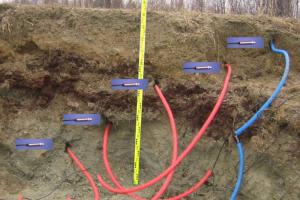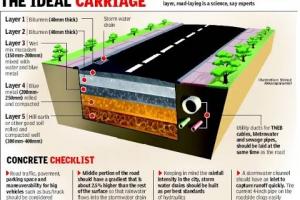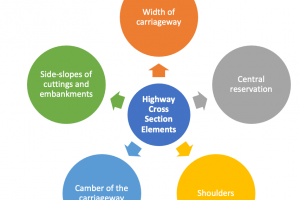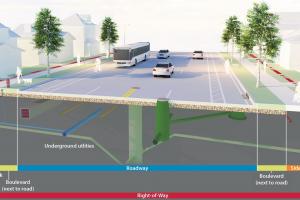What is a Granular Base Course?
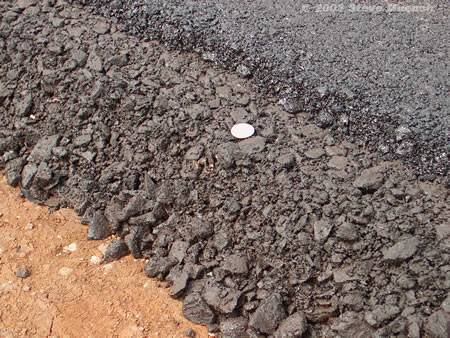
The granular base course refers to a layer of compacted granular material that is used as a foundation or sub-base for various construction projects, particularly in road and pavement construction. It is an essential component of the pavement structure and provides support, stability, and drainage for the upper layers.
The granular base course is typically made up of crushed stone, gravel, or sand, which is selected and processed to meet specific engineering requirements. The material used should have suitable characteristics such as good compaction ability, load-bearing capacity, and resistance to deformation. During construction, the granular base course is spread and compacted in layers to achieve the required density and strength. Compaction is typically carried out using heavy machinery, such as rollers or compactors, to eliminate voids and achieve maximum compaction.
The construction process of a granular base course involves several steps to ensure its proper installation and performance. Here are the general steps involved:
Excavation:
The existing soil or unsuitable material is excavated to the required depth, preparing the subgrade.
Subgrade Preparation:
The subgrade is leveled and compacted to provide a stable and uniform foundation for the granular base course. The existing subgrade, which is the natural or prepared ground, is prepared by removing any vegetation, debris, or unsuitable materials. It is then compacted to achieve the desired density and stability. Subgrade compaction is crucial to prevent future settlement and ensure a solid foundation for the base course.
Placement:
The selected granular material is spread and distributed over the prepared subgrade in layers. Water may be added to aid in compaction. The thickness of each layer may vary depending on the design specifications and anticipated traffic loads. A motor grader or other suitable equipment is used to achieve the desired evenness and uniformity of the base course material.
Grading:
The surface of the compacted base course is typically graded to ensure proper drainage away from the pavement.
Thickness and Specifications:
The thickness of the granular base course depends on the design specifications and the anticipated traffic loads. Engineering standards and specifications provide guidance on the required thickness and material properties.
Functions of Granular Base Course
The primary function of a granular base course is to distribute the load from traffic and other applied forces evenly to the subgrade, which is the natural or prepared ground beneath the road or pavement. By doing so, it helps to minimize the potential for subgrade deformation, settlement, and other forms of pavement distress. The granular base course serves several functions:
1. Load Distribution:
It distributes the loads from traffic and prevents excessive stress on the subgrade, thereby improving the overall stability of the pavement. The primary function of the granular base course is to evenly distribute the loads from traffic and other applied forces, such as vehicles and pedestrians, to the underlying subgrade. By spreading the load over a larger area, it helps to reduce the stress on the subgrade and minimize the potential for deformation or settlement.
2. Drainage:
It allows for the efficient drainage of water, preventing water accumulation within the pavement structure, which could lead to damage and deterioration. The granular base course plays a role in managing moisture within the pavement structure. It acts as a drainage layer, allowing water to infiltrate and move away from the surface, thus reducing the risk of water-related damage and promoting the longevity of the pavement.
3. Subgrade Protection:
It acts as a protective layer, preventing direct contact between the pavement and subgrade layers, thereby reducing the potential for subgrade deformation. The granular base course provides a stable foundation for the overlying layers of asphalt or concrete. It helps to support the weight of the pavement and maintain its structural integrity, preventing cracking, rutting, and other forms of distress. The compacted granular material offers resistance to lateral movement, thereby enhancing the stability of the pavement system.
4. Improved Compaction:
The granular material provides a stable and uniform working platform for subsequent pavement layers, facilitating proper compaction during construction. By providing a consistent and uniform surface, the granular base course helps to create smooth and even pavement. This contributes to a comfortable and safe driving experience for vehicles and enhances the aesthetics of the road.
Overall, the granular base course acts as a crucial layer in the pavement structure, ensuring load distribution, stability, moisture control, good drainage, and a smooth riding surface. Its functions are essential for the long-term performance, durability, and safety of roads and pavements.




